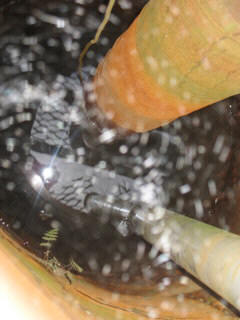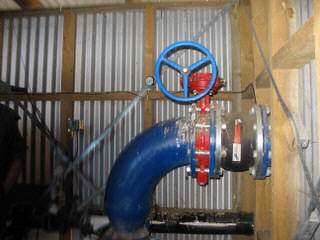
This is the bore on Mr Weir's dairy farm.

This is inside Mr Weir's pump shed. The pump is a hundred and fifty horse power.
Wells/bores are used as a way of getting water to farms. Once this water is at the farm, farmers can use many different types of water applications to irrigate their paddocks. When reading about wells/bores you will be informed about the positives and negatives of them, how they work and other interesting facts.
There is no difference between a well and a bore, but in the olden days a well was known as something that you pull drinking water up from the ground.
Bore water comes from high up in the mountains and it takes years to get from the mountains through underground rivers and lakes to a bore. When it snows the water gets pushed down into a bore faster.
People use number eight wire and computers to find out where water is under the ground. This is called water divining. See 'Water Gathering' for more information.
The positive points of having a bore are that the land value increases, there is the opportunity for irrigation and the security of feed for animals.
The negative points of having a bore are the uncertainties of water (underground aquifer running dry or losing pressure), the rising electricity costs and the possibility of the equipment failing. When a bore has been put onto someone's farm, a submersible pump is put into the water in the casing and then gets hooked up to electricity. Next the water is pumped into underground mains and finally through some type of water application (centre pivot, long line, K line, hard hose gun etc).
A bore can be between three metres deep and two hundred and fifty metres deep – depending on the bore drilling equipment available and the depth of the water.
© 2007 – Page created by: Genevieve


